In 2009, Hereford Cathedral began an extensive restoration of the cathedral close. As part of the project, the area around the cathedral including a graveyard was excavated. More than 700 skeletons dating from the Norman Conquest through the 19th century were unearthed between September of 2009 and May 2011, their bones providing a treasure trove of information about the lives and deaths of people from all walks of life over the course of nearly 1,000 years.
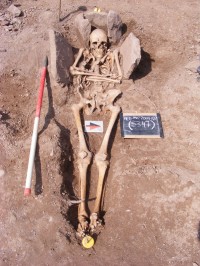 One of the skeletons may be a unique discovery: the remains of a man with wounds that strongly suggest he was fatally wounded in a joust. If that is indeed the case, this skeleton is the first of its kind that we know of ever unearthed in the United Kingdom. He was found buried in the churchyard very near the east end of the Cathedral, prime spiritual real estate due to its proximity to the high altar.
One of the skeletons may be a unique discovery: the remains of a man with wounds that strongly suggest he was fatally wounded in a joust. If that is indeed the case, this skeleton is the first of its kind that we know of ever unearthed in the United Kingdom. He was found buried in the churchyard very near the east end of the Cathedral, prime spiritual real estate due to its proximity to the high altar.
The skeleton is of a well-built adult man 5’10” tall which puts him in the top 5% of men of his era in terms of height. He was at least 45 years old when he died sometime in the late 12th, early 13th century. Stable isotope analysis of his teeth found he was raised in Normandy. He was buried in a grave partially lined with stones, a sort of half-cist burial.
His medical history is writ large on his bones. He had a badly fractured right shoulder blade which had fully healed by the time of his death and a serious break in the lower left leg that had also healed. It’s a twisting fracture, possibly the consequence of a blow to the right side of the body (maybe that shoulder hit?) while on horseback. The twisting may have happened when, in reaction to that blow, the body spun around violently while the left foot remained caught in the stirrup.
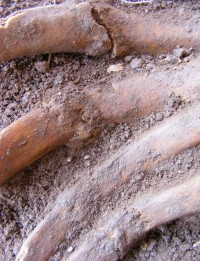 Recovery from such serious breaks doubtless took a long time. It suggests that he fought in tourneys for years before his eventual death. There is no fatal blow that osteologists could find, but there are injuries potentially connected to one. He sustained at least nine rib fractures on two different occasions. The second occasion was the bad one as the rib fracture only shows signs of several weeks worth of healing. The blow to the ribs wasn’t fatal per se, but it was delivered along with the injuries that shortly thereafter claimed his life.
Recovery from such serious breaks doubtless took a long time. It suggests that he fought in tourneys for years before his eventual death. There is no fatal blow that osteologists could find, but there are injuries potentially connected to one. He sustained at least nine rib fractures on two different occasions. The second occasion was the bad one as the rib fracture only shows signs of several weeks worth of healing. The blow to the ribs wasn’t fatal per se, but it was delivered along with the injuries that shortly thereafter claimed his life.
Why couldn’t these wounds have been inflicted during actual combat, you ask? Good question. They could have been, but there are no blade or arrow injuries to the bone. No sharp-force trauma of any kind is extant, although of course he could have been stabbed, speared, shot a million times in his soft tissues without that showing up on the bones.
[Regional Manager of Headland Archaeology] Andy Boucher said “obviously we can never be sure how people came about their wounds, but in this case there is a considerable amount of evidence suggesting this man was involved in some form of violent activity and the locations of his injuries do match quite closely what might be expected from taking part in mock battles. The fact that he was still doing this after he was 45 suggests he must have been very tough.”
If he did die as a result of tourney combat technically he was not allowed church burial. Jousts and its participants had been sternly condemned in the Second Lateran Council of 1139.
We entirely forbid, moreover, those abominable jousts and tournaments in which knights come together by agreement and rashly engage in showing off their physical prowess and daring, and which often result in human deaths and danger to souls. If any of them dies on these occasions, although penance and viaticum [communion] are not to be denied him when he requests them, he is to be deprived of a church burial.
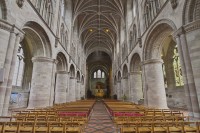 Perhaps burial just outside the physical structure of the church was the loophole used to see that the Hereford knight got a proper Christian burial in a location near the high altar as would suit a man of status despite his death from abominable jousting. Anyway it’s always easier to ask forgiveness after the transgression than permission before so the church’s prohibition had little effect in practice.
Perhaps burial just outside the physical structure of the church was the loophole used to see that the Hereford knight got a proper Christian burial in a location near the high altar as would suit a man of status despite his death from abominable jousting. Anyway it’s always easier to ask forgiveness after the transgression than permission before so the church’s prohibition had little effect in practice.
The Normans had introduced tourneys to England after the Conquest as bona fide war games. The use of heavy cavalry armed with lances to charge in formation developed in the second half of the 11th century, and those formation charges required a great deal of practice to work in a combat situation. These early tourneys were mock battles, not one horseback lancer against another Ivanhoe-style, staged on large fields and fought by dozens, sometimes hundreds, of men at arms. They were dangerous, sometimes fatal, and inflicted more injuries on knights than actual battlefield combat did.
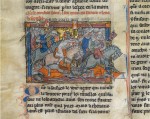 There were prizes to be won, however — ransom money, weapons, armour, horses — and there was always a steady supply of younger sons of nobility with skill at arms but no prospect of inheritance willing to fight their way to wealth and status. Richard the Lionheart attempted to regulate tourneys by issuing a charter on August 22nd, 1194, authorizing them in only five locations and requiring participants to pay hefty fees according to their titles (an earl had to pay 20 marks of silver, a baron 10, a landed knight four marks, a landless knight two) before receiving a license to fight in the tournament. This served the king’s purpose in several ways. It dangled the prospect of profit to the knights, keeping them in the country and available to defend the realm while at the same time keeping them from constantly injuring each other in tourney after tourney. It also made the assembly of large numbers of heavy cavalry subject to monarchical approval, a mechanism that would only grow in importance after Richard’s death and the subsequent clashes between crown and barons that famously resulted in Magna Carta. Last but certainly not least, it put significant coin in the king’s pocket.
There were prizes to be won, however — ransom money, weapons, armour, horses — and there was always a steady supply of younger sons of nobility with skill at arms but no prospect of inheritance willing to fight their way to wealth and status. Richard the Lionheart attempted to regulate tourneys by issuing a charter on August 22nd, 1194, authorizing them in only five locations and requiring participants to pay hefty fees according to their titles (an earl had to pay 20 marks of silver, a baron 10, a landed knight four marks, a landless knight two) before receiving a license to fight in the tournament. This served the king’s purpose in several ways. It dangled the prospect of profit to the knights, keeping them in the country and available to defend the realm while at the same time keeping them from constantly injuring each other in tourney after tourney. It also made the assembly of large numbers of heavy cavalry subject to monarchical approval, a mechanism that would only grow in importance after Richard’s death and the subsequent clashes between crown and barons that famously resulted in Magna Carta. Last but certainly not least, it put significant coin in the king’s pocket.
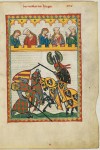 The charter could not quench the thirst for tournaments which were still held outside of the crown’s rules. One famous joust was held at Chepstow Castle on the Welsh side of the border 35 miles south of Hereford in 1227. The castle (called Striguil Castle by the Normans) had been home to William Marshal, dubbed “the greatest knight that ever lived” by Stephen Langton, Archbishop of Canterbury, in his eulogy for William after his death in 1219. His son, also named William, succeeded his father as Earl of Pembroke and Lord Marshal of England to King Henry III. It was the younger William who hosted the 1227 tourney without permission from the king. Knights attached to eight earls, including the Earl of Hereford, fought in the tournament, and at least one of them, Reimund de Burgh, relative of Hubert de Burgh, Henry’s regent during his minority who the king had just that year made the 1st Earl of Kent, was heavily fined for his participation. Thus the king profited financially even from the illicit tourneys.
The charter could not quench the thirst for tournaments which were still held outside of the crown’s rules. One famous joust was held at Chepstow Castle on the Welsh side of the border 35 miles south of Hereford in 1227. The castle (called Striguil Castle by the Normans) had been home to William Marshal, dubbed “the greatest knight that ever lived” by Stephen Langton, Archbishop of Canterbury, in his eulogy for William after his death in 1219. His son, also named William, succeeded his father as Earl of Pembroke and Lord Marshal of England to King Henry III. It was the younger William who hosted the 1227 tourney without permission from the king. Knights attached to eight earls, including the Earl of Hereford, fought in the tournament, and at least one of them, Reimund de Burgh, relative of Hubert de Burgh, Henry’s regent during his minority who the king had just that year made the 1st Earl of Kent, was heavily fined for his participation. Thus the king profited financially even from the illicit tourneys.
Given its proximity to Hereford and the date range of the cathedral’s knight, it’s conceivable that he could have fought in that very tournament. It could even have been the one to fell him, for that matter. I doubt we’ll ever know.
What an exciting discovery. And to think I once lived so near Hereford Cathedral.
Thanks for sharing this great news.
Oh cool! Did you ever have a chance to visit the cathedral when you were nearby?
He certainly looks tightly wedged in between the slabs.
He does. They remind me of those back-and-armrest pillows you get for reading in bed. Only, you know, really hard.
Great post!! I never knew the Church had outlawed jousting. Thanks again for brightening my morning.
My pleasure! I knew they frowned upon it for the same reason they frowned upon the Roman gladiatorial games and because it distracted knights who could otherwise be crusading, but I didn’t realize it was a canon of the Second Lateran Council until I researched this post.
Do you have any more information about the tournament at Chepstow? I am trying to find out what happened to Hugh Mortimer who was injured there – fatally apparently! I would be very grateful for any help!
The only reference I could find was in the Annals of Chepstow Castle and it makes no mention of who else fought there besides Reimund.
More injuries on knights than actual battlefield combat ? Well, whenever survived and added up, Maybe:
A Gergely Paksy (painting: beware of massive head injury) is said to have survived for one year, after having a lance pierce his right eye during a tournament. In an inventory of 1621, however, he is identified as an Hungarian hussar, who suffered this injury while fighting against the Turks.
Of course there were plenty of gruesome and spectacular injuries on the battlefield, but by sheer numbers the tourneys were bound to cause more injuries. Knights fought in tournaments much more often than they did in wars.
Fascinating!
:thanks:
Looks like they got the skeleton out mostly in one piece. A bit eery feeling to look at, but a very interesting article.